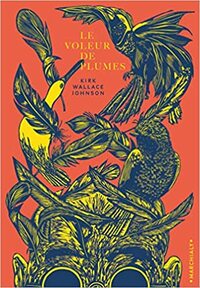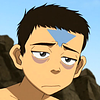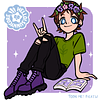You need to sign in or sign up before continuing.
Take a photo of a barcode or cover
last book of 2023!
genuinely a really anticlimactic ending, but with something like this i guess there isn’t any other kind. the part where he starts plucking out the feathers gave me heart palpitations
genuinely a really anticlimactic ending, but with something like this i guess there isn’t any other kind. the part where he starts plucking out the feathers gave me heart palpitations
I listened to this book on a road trip with my teen. It was recommended reading for their AP English class. Finally, something current! What a unfamiliar and fascinating world this book flew us into. It felt quite educational at the start and gave rise to many questions throughout, including: how many suitcases did he have????? This was not a book I would have ever selected for myself, but honestly one I enjoyed and liked discussing with my teen.
adventurous
informative
mysterious
It took me some time to get into this true crime book, but I ended up engaged in the story. I thought Johnson did a masterful job of concisely laying out the history leading up to the theft: Wallace's expeditions that amassed collections of birds, how the birds came to be stored in Tring, the destruction of bird populations due to the fashion industry in the late 19th and early 20th centuries, and the history of fly-tying guides that led to a separate hunger for feathers. Although it initially felt like a rapid jumping from topic to topic, I ended up appreciating how briefly Johnson had managed to cover all the necessary backstory needed to understand the reason for and the impact of the theft at the center of this book.
I initially wasn't sure about Johnson's decision to devote so much of the book to the story of his own investigation, but it became clear that this was the driving suspense of the book; with the identity of the thief no longer a mystery, and spelled out for the reader in the opening pages of the book, the real question was where all the stolen birds and their feathers had ended up and whether any of them were recoverable. Here I felt Johnson was a bit disingenuous, in that the prologue ends with "It would be five consuming years before I finally discovered what happened to the lost birds of Tring," but it's not like the case breaks open suddenly after five years; he pieces together a lot of probabilities over the course of five years, until he feels satisfied that he more or less can guess what happened to the majority of them, but only a few are definitely identified. Still, I found his journey to get there fascinating, and in his initial overview of the life, theft, and trial of Edwin Rist he managed to keep some key elements a surprise until he uncovered them in the course of his investigation.
One thing that bugged me were some timeline inconsistencies: The initial narrative says Rist created his Word document about invading the museum after photographing the birds there, but then the review of evidence introduced in court said that document was created in July 2008 whereas the photographs were taken in November 2008. And then later it says he first reached out to the museum in February 2008, and the narrative made it sound like it was not that long afterwards that he took the photographs. Given that "Was this planned well in advance?" was a key question of the trial, I was frustrated by the lack of clarity there.
On the whole, I'm really glad to have finally picked this up. It was a well-constructed work of nonfiction about a topic I knew nothing about. Johnson made his key point crystal clear: Fly tiers have become so obsessed with creating flies as works of art that will never be used for actual fishing, based on recipes that were made up in the first place and not even related to anything evidence-based about success in fishing, that they're willing to engage in unethical behavior to obtain feathers from birds who are endangered or extinct, including buying stolen museum birds whose value to science is irreplaceable. I do wish Johnson had been a bit more critical of Wallace and the others who saw nothing wrong with traipsing into other parts of the world to kill and collect specimens for science, though I suppose his response to that was that it was the fashion industry who decimated these species, not the scientists. In any case, I look forward to my book club's discussion of this book.
I initially wasn't sure about Johnson's decision to devote so much of the book to the story of his own investigation, but it became clear that this was the driving suspense of the book; with the identity of the thief no longer a mystery, and spelled out for the reader in the opening pages of the book, the real question was where all the stolen birds and their feathers had ended up and whether any of them were recoverable. Here I felt Johnson was a bit disingenuous, in that the prologue ends with "It would be five consuming years before I finally discovered what happened to the lost birds of Tring," but it's not like the case breaks open suddenly after five years; he pieces together a lot of probabilities over the course of five years, until he feels satisfied that he more or less can guess what happened to the majority of them, but only a few are definitely identified. Still, I found his journey to get there fascinating, and in his initial overview of the life, theft, and trial of Edwin Rist he managed to keep some key elements a surprise until he uncovered them in the course of his investigation.
One thing that bugged me were some timeline inconsistencies: The initial narrative says Rist created his Word document about invading the museum after photographing the birds there, but then the review of evidence introduced in court said that document was created in July 2008 whereas the photographs were taken in November 2008. And then later it says he first reached out to the museum in February 2008, and the narrative made it sound like it was not that long afterwards that he took the photographs. Given that "Was this planned well in advance?" was a key question of the trial, I was frustrated by the lack of clarity there.
On the whole, I'm really glad to have finally picked this up. It was a well-constructed work of nonfiction about a topic I knew nothing about. Johnson made his key point crystal clear: Fly tiers have become so obsessed with creating flies as works of art that will never be used for actual fishing, based on recipes that were made up in the first place and not even related to anything evidence-based about success in fishing, that they're willing to engage in unethical behavior to obtain feathers from birds who are endangered or extinct, including buying stolen museum birds whose value to science is irreplaceable. I do wish Johnson had been a bit more critical of Wallace and the others who saw nothing wrong with traipsing into other parts of the world to kill and collect specimens for science, though I suppose his response to that was that it was the fashion industry who decimated these species, not the scientists. In any case, I look forward to my book club's discussion of this book.
man this was wildly fascinating. it’s both a heist story and hobby drama to the extreme
it disappoints me a lot how resistant much of the fly-tying community (at least from how they were portrayed here) were to just,,, using cheaper and more common feathers. most of these people didn’t even fish!! the fancy rare feathers were never necessary!!
i thought how this was written was really captivating, i sped through the story of the heist itself (and i still feel bad for Long Nguyen. the poor guy :/)
all in all, as someone who basically never reads true crime: this was really cool
it disappoints me a lot how resistant much of the fly-tying community (at least from how they were portrayed here) were to just,,, using cheaper and more common feathers. most of these people didn’t even fish!! the fancy rare feathers were never necessary!!
i thought how this was written was really captivating, i sped through the story of the heist itself (and i still feel bad for Long Nguyen. the poor guy :/)
all in all, as someone who basically never reads true crime: this was really cool
informative
fast-paced
As an avid birder, I was drawn to this book in the list of goodreads giveaways. I was extremely impatient while waiting for its arrival and I finished the book in just over a day. Hopefully, I’m giving a review that isn’t too much of a spoiler.
The Feather Thief is told in three parts. Section one describes the history of bird collecting and includes an introduction to fly tying. Section two is about the feather heist itself. Section three shares the author’s quest to find the truth and help solve the remaining mystery. I’m thankful for this section because I was really frustrated at the end of section two.
I do have two worries. It disturbs me to read about the obsession to posses feathers of endangered and extinct species and cut them apart to make fishing lures. I don’t believe all fly tiers have this strategy and I wish it had been addressed in the book. I worry that this book might give some people the desire to use exotic feathers, although I do not believe that was the author’s intent. Also, reading about the details of the theft make me worry about copy-cat attempts. I seriously hope museum curators read the book and consider how they might prevent this type of theft.
Overall, I believe the book was thoroughly researched and well written. I was pulled into the story and wanted to discover the ending. I’m honestly surprised that the author was able to find so many people willing to give interviews. If you are interested in the natural world I believe you will enjoy reading The Feather Thief: Beauty, Obsession, and the Natural History Heist of the Century.
The Feather Thief is told in three parts. Section one describes the history of bird collecting and includes an introduction to fly tying. Section two is about the feather heist itself. Section three shares the author’s quest to find the truth and help solve the remaining mystery. I’m thankful for this section because I was really frustrated at the end of section two.
I do have two worries. It disturbs me to read about the obsession to posses feathers of endangered and extinct species and cut them apart to make fishing lures. I don’t believe all fly tiers have this strategy and I wish it had been addressed in the book. I worry that this book might give some people the desire to use exotic feathers, although I do not believe that was the author’s intent. Also, reading about the details of the theft make me worry about copy-cat attempts. I seriously hope museum curators read the book and consider how they might prevent this type of theft.
Overall, I believe the book was thoroughly researched and well written. I was pulled into the story and wanted to discover the ending. I’m honestly surprised that the author was able to find so many people willing to give interviews. If you are interested in the natural world I believe you will enjoy reading The Feather Thief: Beauty, Obsession, and the Natural History Heist of the Century.
informative
medium-paced
The author using his observations of Edmund Rist during a single interview to determine that Rist was not in fact autistic, as his legal defense had argued, was not the "gotcha" the author thought it was, that part was very off-putting. But otherwise this was a fascinating account of peak human arrogance towards the natural world, and our special ability to transmute biodiversity into a bottom line. Not to mention the total disregard for the heavy hitters of natural history! Good thing Darwin's finches are plain af and not tempting to Victorian fly-tyers!
This book introduces the weird world of salmon fly tying, which is full of wacky obsessives who pine after the feathers of endangered animals used in elaborate salmon flies. Most of them have no interest in catching salmon--this is their art form, and they live to tie. This is the story of one young fly tier who decided to steal scientific specimens from England's Natural History Museum to sell to his fellow tie-flying fiends.
Johnson does a terrific job tracing the history of the preserved birds, the museum, and the origins of salmon fly tying. The first two thirds of this book will take you on a fabulous romp through history, the jungle, and British culture, and you'll cheer when a small-town cop brings down the entitled little asshole who stole the feathers. (You'll be really pissed he serves no time.)
The final third of the book is a bit of a let-down, as Johnson tries to bring some kind of justice and closure to the project and the threads peter out.
Johnson does a terrific job tracing the history of the preserved birds, the museum, and the origins of salmon fly tying. The first two thirds of this book will take you on a fabulous romp through history, the jungle, and British culture, and you'll cheer when a small-town cop brings down the entitled little asshole who stole the feathers. (You'll be really pissed he serves no time.)
The final third of the book is a bit of a let-down, as Johnson tries to bring some kind of justice and closure to the project and the threads peter out.








